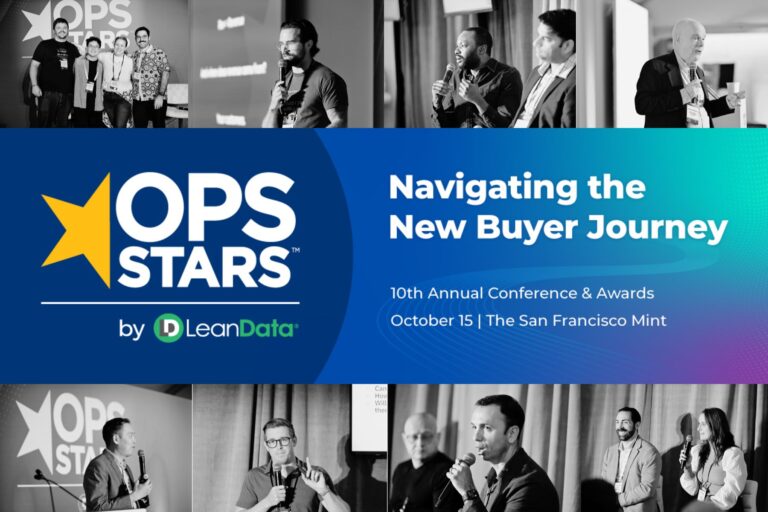The fifth annual OpsStars event looked a bit different this year. Entirely virtual, the show included 30 sessions/workshops and 37 speakers. But, as always, it converged the leading minds in Operations, and demonstrated more than any other year the incredible momentum of Ops adoption – and its impact.
One of my favorite sessions from the event came from LeanData Co-Founder and CEO, Evan Liang. As he said in his closing keynote – Operations is the rising superhero of the modern revenue engine. It is rapidly moving up the value chain, taking on new roles, evolving to be more dynamic, and becoming the future masterminds of the whole go-to-market (GTM) engine.
“Ops is moving from a systems admin role to one that drives strategy and designs the GTM of the future.”
To understand where the operations role is going, Evan explained where it’s been.
Evolution of Ops
1. The pre-ops revenue world
30 years ago, revenue growth came from two tools: a phone and a rolodex. The rolodex was gold. It is what every AE really valued, and it would follow them from company to company. Back in those days, the sales rep was the master of his/her domain.
In this environment, Ops didn’t really have a role beyond perhaps the executive admin function. There was no standard process for sales as to what they did or did not do. There also wasn’t a lot of technology around it. Success was up to the skill of each rep which would determine how much they’d close for the organization.
-
- People: sales rep is the king/queen, ops were admin support
- Process: up to each rep
- Technology: rolodex, phone
But, as we know today, technology has a way of being disruptive. If you consider the three pillars of people, process, and technology, oftentimes if there’s a major disruption in tech, it can drive change to people and process. That’s what we see happening in Ops.
2. The birth of Ops and systems of record
The first technological disruption to this space was CRM, and later, marketing automation. These were essentially systems of record, digitizing those rolodexes into a machine so we could analyze them. Revolutionary for their time, these systems of record created the birth of the operations role as we know it today.
Ops was the answer to the question, “How do we manage these great new systems and capture that data?” At this stage, Ops worked with management so they could understand the sales process, taking it away from an individual trade, and making it digital, repeatable, and more scalable.
-
- People: manage systems, provide reports
- Process: data capture, metrics for everything
- Technology: systems of record, CRM, marketing automation
Today, organizations like ours and others who sponsored Ops Stars 2020 are building essential business processes that span multiple systems of record. These new tech layers on top of systems of record make the GTM process more efficient. For example, LeanData is the leader in Lead-to-Account Matching and Routing, managing the handoff between sales and marketing, making sure the right leads are getting to the right reps. With this automation comes power and the ability for Ops professionals to evolve from not only digitizing the system, but to also managing strategic business processes.
3. The growth of Ops and systems of insight
What comes after a great system of record and automated business processes? Systems of insight. The future of Ops is around using these systems of insight to predict what’s going to happen. Technology like artificial intelligence and machine learning play a role, but this shift is not about turning over the whole process to machines.
Evan explained:
“A machine cannot tell you how to run your go-to-market -that is where the Ops professional plays an important role. Someone needs to be the mastermind behind it.”
Today, the role of Ops is shifting to be more strategic, and more proactive. The modern Ops professional is given business problems and the freedom to solve that across tactics and technology.
-
- People: automate processes, solve business problems
- Process: inbound/outbound, ABM, shape operations around CX
- Technology: systems of engagement, L2A matching and routing, etc.
As we shift to this era of Ops, instead of optimizing business processes, organizations are optimizing for business objectives. GTM systems are designed to scale — but scaling high-growth revenue strategy looks very different than optimizing GTM for profitability. These different flavors require a dynamic, strategic Ops mastermind to design it accordingly.
-
- People: designing GTM strategy, solving business objective
- Process: end-to-end GTM system, optimize for growth vs. profitability
- Technology: systems of insights, tech-enabled
As you can tell, there is an exciting future for Ops professionals. It really is a time for Ops to shine. For more on the rise of Ops, I encourage you to check out all of our on-demand OpsStars sessions, including Evan’s full closing keynote featuring a conversation with Lars Nilsson, VP of Global Sales Development at Snowflake.






